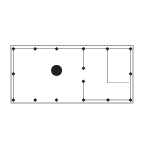Villa Flotilla
What biology ensues when you inject a swarm typology with program? The site of Villa Flotilla is the Tonle Sap Lake, located in northern Cambodia. It is the largest freshwater basin in Southeast Asia. It houses a population of over 1.2 million people and over 250 species of bird and fish. Unfortunately, due to the stresses of rapid modernization, the wellbeing of the lake and the populations it supports are at risk. The program of this intervention is threefold. Villa Flotilla will introduce facilities for medical screening, biological and endocrinological research, and classrooms.
The strategy to implement these three programs is to pair two of three within the framework of a flexible module. In that way, the module can act as a discreet programmatic cell anywhere on the lake.
Pairings:
Research + Classroom
Research + Medical Screening Rooms
Classroom + Medical Screening Rooms
Given the biological nature of the swarm, the symbiosis inherent to each discreet cell can be amplified by the replication and “clotting” of a multitude of cells in response to changing health concerns and ecological needs around the lake.
The format of each module is straightforward: a concrete frame on a concrete hull. The concrete hull houses all of the mechanical systems below deck, and the concrete frame can be infilled with any number of available materials including compressed earth bricks, CMU blocks, fabric, corrugated plastic or metal, or bamboo depending on varying programmatic and sanitary needs. Both the specific biology of the module and the systemic biology of the swarm are capable of change.
The formal language of Villa Flotilla borrows from modernism, but is inflected by the ad-hoc culture of Cambodian construction. It recalls the bay-type construction of the Cambodian city and mobilizes it with hydraulic properties.
Program: Medical/Research/Education
Location: Chong Khneas, Cambodia
Year: 2015
Copyright © 2018 Evio Isaac




